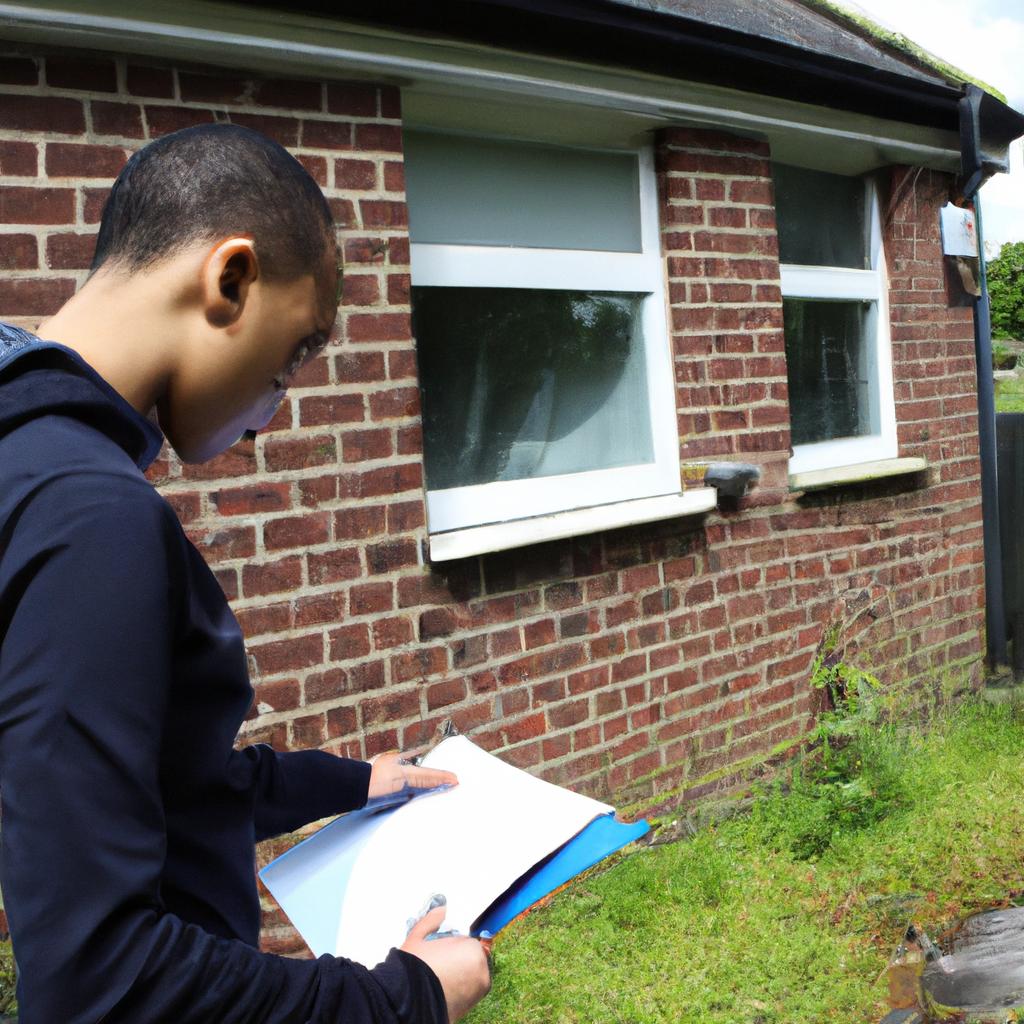Insurable Property Damage in Relief and Damages: An Informational Overview
In recent years, there has been a significant increase in natural disasters such as hurricanes, floods, wildfires, and earthquakes. These catastrophic events have caused extensive damage to properties, resulting in numerous insurance claims being filed for relief and damages. For instance, consider the case of a coastal community that was ravaged by a Category 5 hurricane. Countless homes and businesses were destroyed or severely damaged, leaving residents devastated and seeking financial assistance from their insurance providers.
This article aims to provide an informational overview of insurable property damage in relation to relief and damages. By examining the fundamental concepts surrounding this subject matter, we can gain insight into how individuals can navigate the complex process of filing insurance claims for property damage caused by unforeseen circumstances. Furthermore, understanding the various types of coverage available under different policies will enable policyholders to make informed decisions when selecting appropriate levels of protection for their valuable assets. Through comprehensive analysis and exploration of relevant legal principles and precedents, readers will be equipped with essential knowledge to effectively safeguard their interests in times of crisis.
Types of Insurable Damages
When it comes to insuring property, understanding the different types of damages that can be covered is crucial. This section provides an overview of various insurable damages and their significance in terms of relief and compensation. To illustrate this further, we will explore a hypothetical scenario involving a homeowner who has experienced property damage due to a natural disaster.
Types of Insurable Damages:
-
Physical Damage: The most common type of insurable damage is physical damage caused by events such as fire, storms, or vandalism. In our case study, let’s consider a homeowner whose house was severely damaged by a hurricane. The resulting destruction includes structural damage, roof leaks, and broken windows. These tangible losses fall under the category of physical damage which could potentially be covered by insurance.
-
Loss of Use: Another important aspect to consider is loss of use or additional living expenses incurred when a property becomes uninhabitable due to the insured peril. Following our hypothetical scenario, if the homeowner’s residence is deemed unsafe after the hurricane, they may need to find alternative accommodations temporarily. Insurance coverage for loss of use aims to reimburse these additional costs until the home is repaired or rebuilt.
-
Personal Property Damage: Beyond the structure itself, personal property within the premises can also suffer from insurable damages. Household items like furniture, appliances, electronics, and clothing are vulnerable during events like fires or floods. Insurance policies typically provide coverage for replacing or repairing damaged personal belongings up to certain limits outlined in the policy agreement.
-
Liability Coverage: While liability coverage does not directly address physical property damage, it plays a vital role in protecting homeowners against potential legal claims arising from accidents on their premises or actions taken by individuals visiting their property. For instance, if someone sustains injuries while on the homeowner’s premises due to unsafe conditions caused by the hurricane-related destruction (such as fallen debris), liability coverage would help cover legal expenses or potential damages awarded to the injured party.
Emotional Impact:
Consider the emotional toll of experiencing property damage. Imagine returning home after a devastating event, such as our hypothetical hurricane, only to find your cherished possessions destroyed and your living space uninhabitable. The financial burden of repairing or replacing damaged items can be overwhelming. Insurance coverage provides relief in these distressing situations, offering protection and assistance during challenging times.
Coverage for Physical Damage:
Understanding the different types of insurable damages is essential when navigating insurance claims. However, focusing on physical damage specifically warrants further exploration.
Coverage for Physical Damage
Insurable Property Damage: Coverage for Physical Damage
In the previous section, we explored various types of insurable damages that can occur to properties. Now, let’s delve into the coverage provided specifically for physical damage under insurance policies. To illustrate this further, consider a hypothetical scenario where a homeowner experiences significant water damage due to a burst pipe in their kitchen.
Coverage for physical damage varies depending on the specific policy and its terms. However, it typically includes protection against events such as fire, theft, vandalism, natural disasters (e.g., earthquakes or hurricanes), and accidents like the one mentioned above. In our example case study, the homeowner would be eligible to file an insurance claim to seek compensation for the cost of repairing or replacing damaged property resulting from the water incident.
To better understand coverage options for physical damage, let us examine some key considerations:
- Policy Exclusions: It is important to review your insurance policy carefully as certain perils may not be covered. For instance, some policies might exclude flood-related damages or intentional acts by policyholders.
- Deductibles: Insurance policies often require policyholders to pay a deductible before receiving compensation. The deductible amount can vary based on factors like coverage type and policy terms.
- Limits of Liability: Policies also specify maximum limits on how much insurers are obligated to pay out for physical damages. Understanding these limits helps homeowners determine if additional coverage is necessary.
- Additional Endorsements: Policyholders may have options to add endorsements or riders to their existing policies. These additions offer supplementary coverage for unique situations that fall outside standard policy provisions.
- 🌟 Ensure you fully comprehend what perils are excluded from your policy so you can take appropriate precautions.
- 🌟 Be aware of the potential financial impact caused by deductibles when filing claims.
- 🌟 Understand the limits of liability to make informed decisions about your coverage needs.
- 🌟 Consider additional endorsements that might provide extra protection for specific risks you may face.
To further aid our understanding, let’s explore a table outlining the common types of physical damage covered under insurance policies:
| Type of Damage | Examples | Coverage Status |
|---|---|---|
| Fire | Structural damage from fire | Typically Covered |
| Theft | Stolen possessions | Typically Covered |
| Vandalism | Graffiti on property | Typically Covered |
| Natural Disasters | Roof damage due to a tornado | Coverage May Vary |
By considering these key points and familiarizing ourselves with potential scenarios like the burst pipe incident mentioned earlier, we can better prepare ourselves as policyholders. Understanding relief and damages becomes crucial in navigating through insurance claims, which will be explored in detail in the subsequent section.
Transitioning into the next section, it is essential to comprehend how understanding relief and damages plays an integral role in successfully managing insurance claims.
Understanding Relief and Damages
Section Transition:
Building upon the understanding of coverage for physical damage, this section delves into the intricate realm of relief and damages. By exploring various aspects related to insurable property damage, we can gain valuable insights into how individuals or entities seek compensation for losses incurred.
Understanding Relief and Damages:
To illustrate the significance of relief and damages, let us consider a hypothetical scenario. Imagine a small business owner who experiences severe water damage due to an unexpected pipe burst in their office space. As a result, vital equipment is rendered unusable, leading to significant financial losses. In such cases, seeking relief becomes crucial for the affected party.
When it comes to filing claims for property damage, there are several key points to keep in mind:
- Evidence collection: Gathering substantial evidence regarding the extent of the damage is essential while seeking relief.
- Documenting costs: Accurately documenting all expenses associated with repairing or replacing damaged property ensures fair reimbursement.
- Time sensitivity: Initiating the claim process promptly after discovering the damage helps prevent any potential complications.
- Professional support: Engaging experts such as public adjusters or attorneys specializing in insurance claims can significantly enhance one’s chances of obtaining appropriate compensation.
The journey towards attaining relief and damages can be emotionally challenging:
- Uncertainty about future financial stability
- Frustration caused by bureaucratic processes
- Anxiety stemming from prolonged settlement negotiations
- Disappointment when facing exclusions or limitations within policy terms
Table Example (markdown format):
| Challenges | Impact |
|---|---|
| Financial strain | High |
| Delayed settlements | Moderate |
| Limited coverage scope | Medium |
| Emotional distress | Varies |
As we delve into the subsequent section on “Exclusions and Limitations,” it is crucial to grasp the potential hurdles one might encounter when seeking relief and damages for insurable property damage.
Exclusions and Limitations
Understanding Relief and Damages
In the previous section, we explored the concept of relief and damages in insurance claims. Now, let us delve into a specific aspect of insurable property damage to gain a comprehensive understanding.
Consider a hypothetical scenario where a homeowner experiences significant water damage due to a burst pipe. The homeowner files an insurance claim seeking relief for the incurred expenses, such as repairing the damaged walls, replacing furniture, and addressing any mold-related issues. This case study serves as an example to illustrate various facets of insurable property damage.
To better grasp this topic, it is essential to be familiar with some key aspects related to relief and damages:
- Types of Property Damage: Insurable property damage can encompass various situations beyond water damage mentioned earlier. It may include fire or smoke damage, vandalism, theft, natural disasters like hurricanes or earthquakes, and more.
- Covered Perils: Insurance policies typically outline specific perils covered under their terms. These perils refer to events that cause property damage and qualify for potential coverage.
- Policy Limits: Policies often impose limits on reimbursement amounts for different types of property damage. These limits might vary based on factors such as policy type (homeowners’ insurance vs. renters’ insurance) or additional coverage options chosen by the insured.
- Deductibles: Deductibles are predetermined amounts that policyholders must pay out-of-pocket before their insurance coverage kicks in. Higher deductibles generally result in lower premium costs but may require greater financial responsibility at the time of filing claims.
Let’s take a moment to reflect on how these elements intertwine using a table format:
| Aspect | Explanation |
|---|---|
| Types of Damage | Water damage, fire/smoke damage, vandalism |
| Covered Perils | Burst pipes/flooding incidents; electrical fires |
| Policy Limits | $10,000 maximum reimbursement for water damage; $50,000 limit for fire-related damages |
| Deductibles | $500 deductible for any property damage claims |
Understanding these facets of insurable property damage can help policyholders navigate the complex landscape of insurance claims more effectively. By having a clear understanding of their coverage limits and deductibles, individuals can make informed decisions when seeking relief for incurred losses.
As we move forward in our exploration of insurance claims, let us now shift our focus to another crucial aspect: factors that influence the outcome of an insurance claim. Understanding these factors will provide valuable insights into how insurers assess and determine the appropriate relief or compensation for policyholders affected by property damage.
[Transition Sentence]: With this groundwork laid, we shall now delve into the factors affecting insurance claims and gain a deeper understanding of their significance.
Factors Affecting Insurance Claims
While understanding the exclusions and limitations is crucial, it is equally important to consider the factors that can affect insurance claims. By examining these factors, individuals can ensure a smoother claims process and increase their chances of obtaining relief and damages for insurable property damage.
To illustrate how various elements influence insurance claims, let us consider an example scenario. Imagine a homeowner who experiences significant water damage due to a burst pipe in their residence. The following paragraphs will delve into key factors that could impact this homeowner’s ability to file a successful claim.
Firstly, prompt reporting plays a vital role in insurance claims. Delays in notifying the insurer about the incident may lead to complications or even denial of coverage. In our case study, if the homeowner promptly informs their insurance company about the burst pipe incident, it allows adjusters to assess the extent of damage while it is still fresh and accurately evaluate compensation requirements.
Secondly, thorough documentation strengthens an individual’s claim by providing evidence of loss or damage sustained. Detailed records such as photographs, videos, receipts for repairs or replacements, and any relevant correspondence with contractors help substantiate the value of claimed losses. Our hypothetical homeowner should diligently document all expenses incurred during restoration efforts as well as communicate effectively with professionals involved.
Thirdly, policyholders must be aware of policy limits and deductibles associated with their coverage plans. These restrictions can significantly impact potential reimbursement amounts for insurable property damage. Understanding what costs fall within deductible thresholds ensures realistic expectations regarding compensable losses. For instance, our homeowner needs to review their insurance policy carefully to determine which aspects of water damage are covered and up to what monetary limit.
Lastly but importantly, engaging professional assistance can greatly enhance the claims process. Insurance claim adjusters, public adjusters, or legal experts possess specialized knowledge and experience in navigating complex insurance procedures. Their expertise ensures that policyholders receive fair compensation for their insurable property damage.
| Factor | Impact |
|---|---|
| Prompt reporting | Enables accurate assessment of damages |
| Thorough documentation | Provides evidence to support the value of claimed losses |
| Policy limits and deductibles | Significantly affect reimbursement amounts |
| Professional assistance | Enhances the chances of receiving fair compensation |
In conclusion, understanding these factors is crucial when filing an insurance claim for insurable property damage. By promptly reporting incidents, maintaining thorough documentation, being aware of policy limitations, and seeking professional guidance as necessary, individuals can maximize their chances of obtaining relief and damages from their insurer.
Considering the various factors affecting insurance claims provides a solid foundation for successfully navigating the next steps involved in filing an insurance claim.
Steps to File an Insurance Claim
In the previous section, we discussed the various factors that can affect insurance claims. Now, let’s delve deeper into understanding these factors and their implications for individuals seeking relief and damages.
To illustrate how these factors play a role in insurance claims, consider the following hypothetical scenario: John owns a small business that recently experienced significant property damage due to a fire. He has comprehensive insurance coverage for his property and intends to file an insurance claim to receive compensation for the incurred losses.
When filing an insurance claim for property damage, several key factors come into play:
-
Policy Coverage: The extent of coverage provided by John’s insurance policy will determine which aspects of his property damage are eligible for compensation. This may include structural repairs, damaged inventory or equipment replacement costs, and even potential business interruption expenses.
-
Documentation: Accurate documentation is crucial when filing an insurance claim. John needs to gather evidence such as photographs, videos, receipts, and any other relevant records detailing the extent of the damage suffered. These documents serve as tangible proof to support his claim during the evaluation process.
-
Evidence Evaluation: Once John submits his claim to the insurer, it undergoes a thorough evaluation process. An adjuster appointed by the insurance company assesses the submitted evidence alongside applicable policy terms and conditions to determine if all requirements have been met.
-
Claims Settlement: After evaluating all aspects of John’s claim, including coverage limits and deductibles specified in his policy, the insurer will provide him with a settlement offer. If both parties agree on the amount offered, John will receive financial compensation within a reasonable timeframe.
Now that we have explored these factors affecting insurance claims in-depth through our example scenario let us take a moment to understand some emotional responses commonly associated with this process:
- Frustration: Dealing with extensive paperwork and navigating complex procedures can be overwhelming.
- Anxiety: Uncertainty regarding the outcome of the claim and its potential impact on personal or business finances.
- Relief: Receiving a fair settlement offer can provide a sense of relief, knowing that financial assistance is forthcoming.
- Empowerment: Successfully navigating the insurance claim process can instill confidence in individuals to handle future adversities.
To summarize, understanding the factors influencing insurance claims is essential when seeking relief and damages for property damage. By considering policy coverage, gathering accurate documentation, undergoing evidence evaluation, and negotiating a fair settlement, individuals can navigate this process successfully and achieve a favorable outcome.




